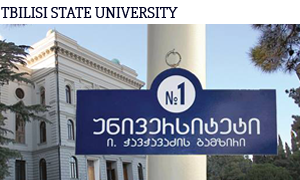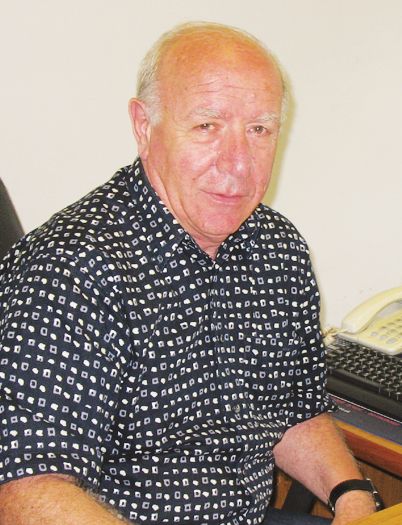
SCIENTIFIC INSTITUTE
The TSU High Energy Physics Institute and Current Challenges
The High Energy Physics Institute, founded on June 9, 1980, was built on the successes of the High Energy Nuclear Physics Problem Laboratory, which was a part of Tbilisi State University. The founders were Academicians Nodar Amaglobeli, Albert Tavkhelidze, Teimuraz Kopaleishvili and Revaz Salukvadze. The new Institute was created as an entity with its own budget, to encourage theoretical and experimental research in the fields of elementary particles, relativistic nuclear physics, and quantum field theory. The Institute’s first Director was Nodar Amaglobeli who led the Institute for 16 years. The following Director was the former President of the Georgian National Academy of Sciences, Albert Tavkhelidze. Professor Mikheil Nioradze, Doctor in Physics and Mathematical Sciences, was named Director in 2004.
A SHORT HISTORY
 Research in the field of high energy or elementary particle physics seeks to establish the fundamental laws of structural matter, in other words to create a true picture of the formation of the Universe. All experimental studies in this area require enormous amounts of material and financial resources to access the latest technologies and achievements of modern engineering. Creating the material and technical basis for such research exceeds the means of even the most advanced countries. This induced countries to make joint efforts to create international scientific centers for basic research in these fields. The necessary conditions for a country’s participation in the research work of these international centers has always been to have highly qualified specialists as well as a national research center that has a high standing within international scientific circles.
Research in the field of high energy or elementary particle physics seeks to establish the fundamental laws of structural matter, in other words to create a true picture of the formation of the Universe. All experimental studies in this area require enormous amounts of material and financial resources to access the latest technologies and achievements of modern engineering. Creating the material and technical basis for such research exceeds the means of even the most advanced countries. This induced countries to make joint efforts to create international scientific centers for basic research in these fields. The necessary conditions for a country’s participation in the research work of these international centers has always been to have highly qualified specialists as well as a national research center that has a high standing within international scientific circles.
In Georgia one such center is the High Energy Physics Institute (HEPI) at Tbilisi State University. Before winning international recognition, the HEPI went through a long preparatory period beginning in the 1960s. During that decade, after successfully finishing their first steps of a successful scientific career at the Joint Institute for Nuclear Research (JINR) in the Russian Dubna Acadamy, Nodar Amaglobeli and Revaz Salukvadze created the High and Intermediate Energy Physics Departments within the Nuclear Physics Laboratory of Tbilisi State University, directed by Professor Ivane Vashakidze. A Department of Theoretical Nuclear Physics was also created at the same time, headed by Academician Teimuraz Kopaleishvili.
Subsequently the foundations were laid for an Automatic Processing Center for Information from the high energy physics experiments, directed by Academician N. Amaglobeli. This was one of the first centers among the universities and research institutes of the Soviet Union to work on high energy physics. It allowed our young physicists to become full participants of joint research conducted in Dubna and Serpukhov. Participation in these experiments and close contacts with the collaborators of these leading scientific centers played a key role in preparing the younger scientific generation to help them become highly qualified.
Thus the foundations for a strategic plan were laid, and led to the creation of a modern scientific research center in the field of High Energy Physics in Georgia. Academician Albert Tavkhelidze, who worked in JINR at this time, inspired and headed the strategy plan. Soon a strong foundation was in place to create the Problem Laboratory for High Energy Nuclear Physics and the High Energy Physics Institute (HEPI).
The HEPI played an important role in popularizing and developing the field of physics in Georgia. For example, the prestigious international Rochester Conference was held at TSU in 1976, attended by 1200 scientists from all over the world. This meeting is held every two years, alternatively in the USA and Europe/Asia and that year it had a great historical significance for Georgia and for the world: Data was presented for the first time on the discovery of the fourth charm c-quark and (tau) lepton, which indicated the validity of the quark model of the structure of matter (Murray Gell-Mann, George Zweig). For the final confirmation of the validity of this model it was necessary to restore symmetry between fundamental particles – quarks and leptons (6 quarks and 6 leptons)--this symmetry was subsequently confirmed with the discovery of the bottom (b) and top (t) quarks (Leon Lederman’s group and CDF, D0 experiments, respectively).
The existence of a laboratory within the Institute promoted the development of modern experimental methods in high energy physics. New technology for the production of multi-wire proportional chambers was developed, which permitted the Institute to take part in experiments at the Serpukhov accelerator where they were installed.
Young Georgian physicists made an essential contribution to experimental and theoretical research that was conducted between Tbilisi, Dubna and Serpukhov. Theoretical research was generally carried out in quantum field theory and the fundamental properties of elementary particles and nuclei. Experimental research addressed the interaction of relativistic nuclei and mesons with nucleons and nuclei, strange particles and hyperons physics, and the search for new particles. The experimental and theoretical research carried out by Georgian physicists during this period was highly acclaimed, and won several prizes: The USSR State Prize (T.Kopaleishvili -1977); the Georgian State Prize (N.Amaglobeli, V.Kekelidze, G.Nikobadze, V.Jorjadze – 1985); and other awards the N.Muskhelishvili Award (T.Kopaleishvili – 1977) and the P.Melikishvili Award (N.Amaglobeli, M.Chargeishvili, Z.Salukvadze, I.Tevzadze – 1976; and A.Khelashvili – 1983).
PRESENT RESEARCH
 In recent decades experimental discoveries and theoretical insights have significantly advanced our understanding of elementary particles and the forces acting between them. In modern theory of elementary particle physics a combination of theories of strong (Quantum Chromo Dynamics, QCD) and electroweak interactions, called the Standard Model (SM), is very effectively used. Its discovery should be viewed as one of the great scientific triumphs of the twentieth century.
In recent decades experimental discoveries and theoretical insights have significantly advanced our understanding of elementary particles and the forces acting between them. In modern theory of elementary particle physics a combination of theories of strong (Quantum Chromo Dynamics, QCD) and electroweak interactions, called the Standard Model (SM), is very effectively used. Its discovery should be viewed as one of the great scientific triumphs of the twentieth century.
Despite the fact that no experimental results have contradicted the SM—and indeed many of its predictions have been experimentally confirmed—there are still unanswered questions in elementary particle physics. Some key questions include why mass hierarchy exists and what is the origin of mass; why is the symmetry broken between matter and anti-matter in our universe; do super-symmetry particles exist or not; black holes and additional issues. There are many theoretical models besides the Standard Model (“New Physics”), which answer these questions more or less successfully. But physics is an experimental science, and only new experimental data will be able to properly address these questions and uncover whatever new surprises lie ahead.
Testing the SM and probing for new phenomena with accelerators can be roughly categorized into three approaches--experiments with high intensity beam, experiments at the highest possible energies, and precision experiments.
COOPERATION WITH THE PAUL SCHERRER INSTITUTE (PSI), ZURICH, SWITZERLAND
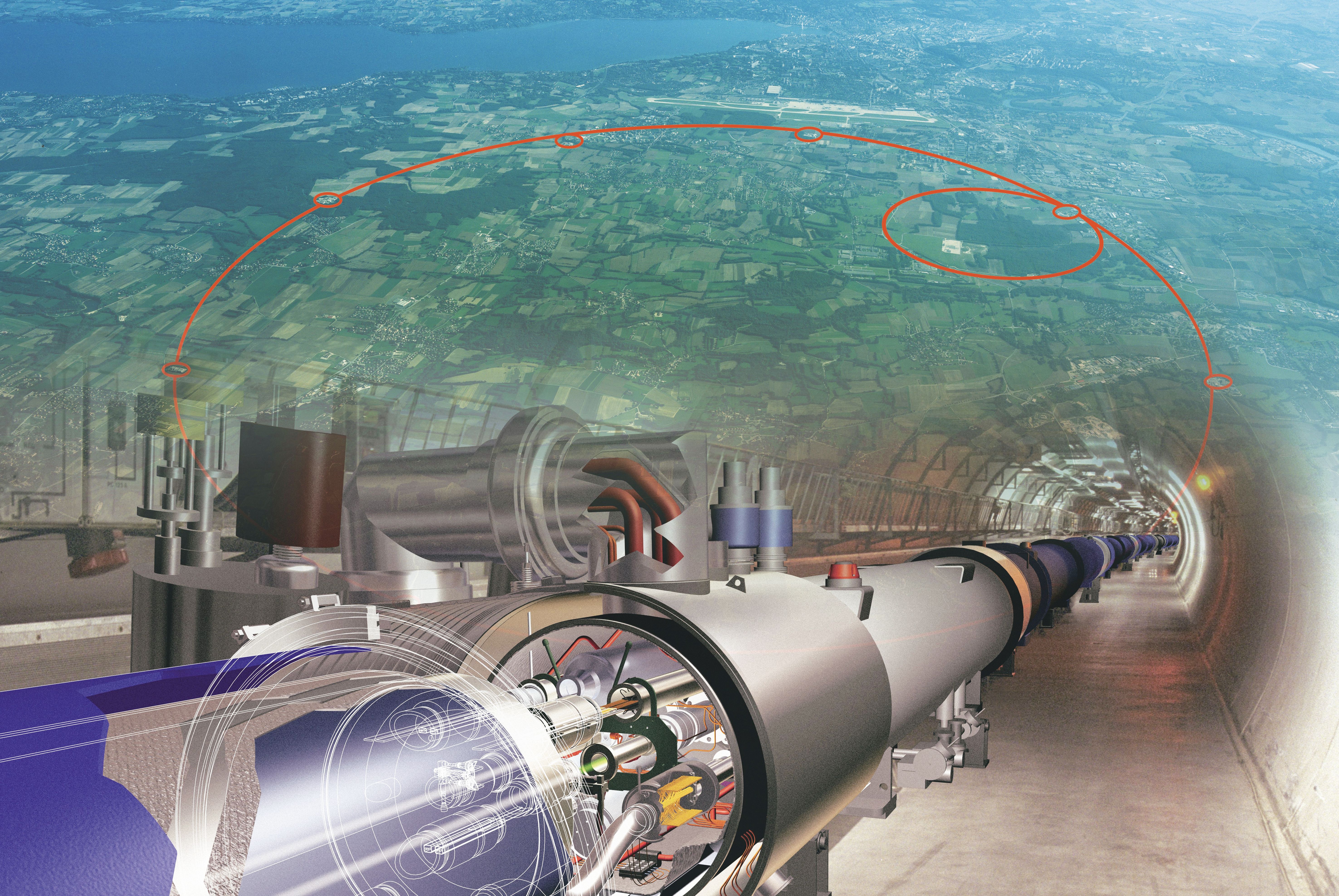 The first step for testing the Standard Model and hunting for new physics involves research on very rare or even “forbidden” processes. Such accelerator experiments require a high intensity beam. Research in this direction began about thirty years ago at the synchrotron of the Paul Scherrer Institute in Switzerland. The first experiments outside the former Soviet Union in which the Georgian scientists participated were the PiBeta and MMbar experiments planned for this accelerator in an international framework. The PSI accelerator has the most intense pion and muon beams in the world, and for the PiBeta experiment the laboratory in Tbilisi constructed the electromagnetic calorimeter needed, using CzI crystals.
The first step for testing the Standard Model and hunting for new physics involves research on very rare or even “forbidden” processes. Such accelerator experiments require a high intensity beam. Research in this direction began about thirty years ago at the synchrotron of the Paul Scherrer Institute in Switzerland. The first experiments outside the former Soviet Union in which the Georgian scientists participated were the PiBeta and MMbar experiments planned for this accelerator in an international framework. The PSI accelerator has the most intense pion and muon beams in the world, and for the PiBeta experiment the laboratory in Tbilisi constructed the electromagnetic calorimeter needed, using CzI crystals.
The main aim of the PiBeta experiment was to determine the (π+π0e+υ) decay rate, which offers one of the most precise means for testing the SM, which gave a very small magnitude for this value. As the experiment’s sensitivity was adjusted to a finer level the results coincided well with the SM prediction that specifies model validity.
The goal of the MMbar experiment was to search for a spontaneous conversion of muonium (M=µ+e-) to antimuonium (Mbar=µ-e+). This reaction is not found in the SM of electroweak interactions and its observation would be a direct signal of the new physics beyond it. In the course of the experiment more than 50 billion muonium atoms were investigated for Mbar decays, and no decays of an antimuonium atom were observed.
COOPERATION WITH EUROPEAN ORGANIZATION FOR NUCLEAR RESEARCH (CERN, GENEVA, SWITZERLAND)
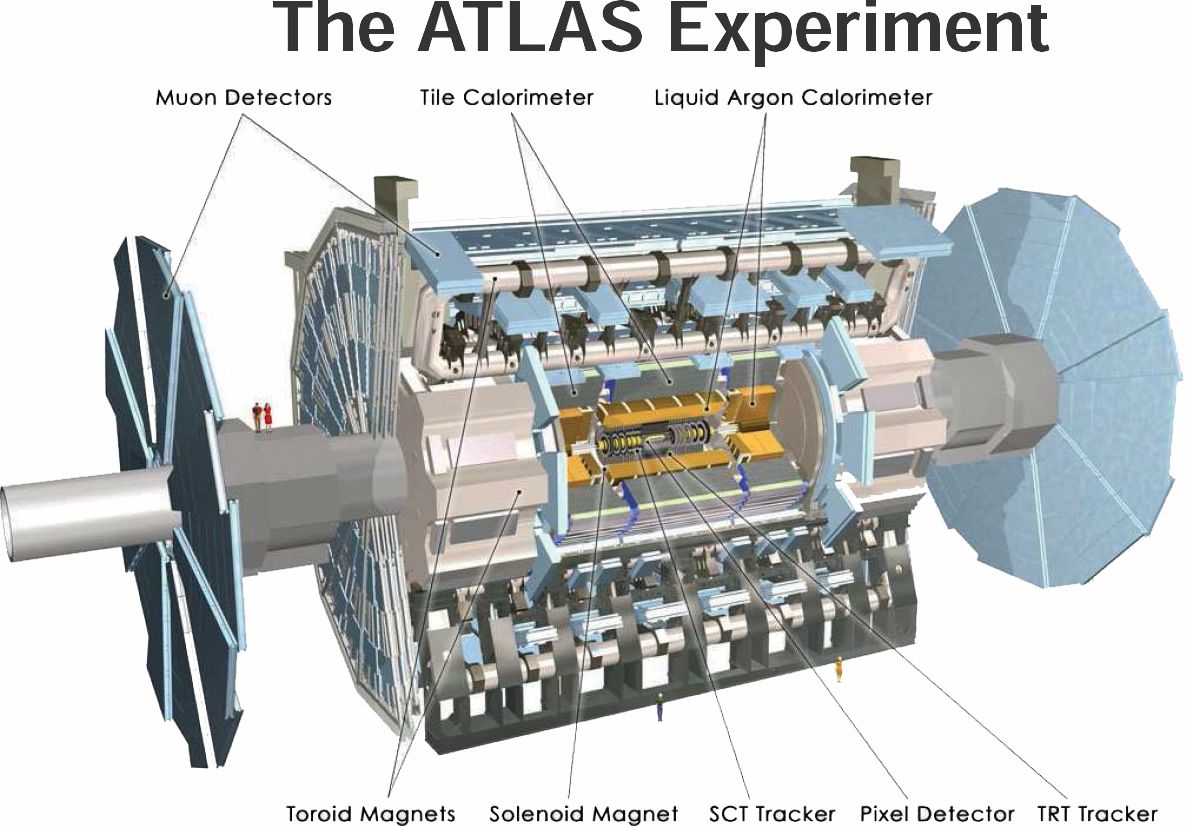 The paramount task in modern physics is to study the mechanism for the origins of the fundaments of existence – mass! The mechanism offered by the English physicist Peter Higgs is the basis of the Standard Model. Put as simply as possible: It is known that there are four types of interaction in nature: gravitational, strong, electromagnetic and weak. A beautiful theory that unites electromagnetic and weak interactions - the electro-weak theory--was created by Sheldon Gleshou, Abdul Salam and Steven Weinberg. The carrier of electromagnetic interaction is the massless particle, photon. For description of weak interaction three massive particles of W+, W- and Z0 bosons were introduced, mass of which 80-90 times exceeding proton mass. These particles were discovered later by Karlo Rubiya and Simon van der Meer. According to the electro-weak theory, photons and these bosons have to belong to one family and there has to be certain symmetry between them, i.e. as a result of transformations they have to pass into each other. This statement caused bewilderment because it was not understood how such particles could belong to one family and be mutually reflected, with such difference in mass particles. The contradiction can be eliminated if one assumes that initially there was symmetry in nature and all particles were massless. However, at the time of the origin of the universe the symmetry of electro-weak interactions was spontaneously broken, and carriers of weak interaction—bosons-- acquired mass. These considerations underlie the Higgs mechanism.
The paramount task in modern physics is to study the mechanism for the origins of the fundaments of existence – mass! The mechanism offered by the English physicist Peter Higgs is the basis of the Standard Model. Put as simply as possible: It is known that there are four types of interaction in nature: gravitational, strong, electromagnetic and weak. A beautiful theory that unites electromagnetic and weak interactions - the electro-weak theory--was created by Sheldon Gleshou, Abdul Salam and Steven Weinberg. The carrier of electromagnetic interaction is the massless particle, photon. For description of weak interaction three massive particles of W+, W- and Z0 bosons were introduced, mass of which 80-90 times exceeding proton mass. These particles were discovered later by Karlo Rubiya and Simon van der Meer. According to the electro-weak theory, photons and these bosons have to belong to one family and there has to be certain symmetry between them, i.e. as a result of transformations they have to pass into each other. This statement caused bewilderment because it was not understood how such particles could belong to one family and be mutually reflected, with such difference in mass particles. The contradiction can be eliminated if one assumes that initially there was symmetry in nature and all particles were massless. However, at the time of the origin of the universe the symmetry of electro-weak interactions was spontaneously broken, and carriers of weak interaction—bosons-- acquired mass. These considerations underlie the Higgs mechanism.
 According to the Higgs model, the whole universe is filled with a uniform, invisible field – called “Higgs’ Field”. In relativistic quantum field theory a particle is considered as the quanta of oscillations of the corresponding fields: electrons – oscillations of electric field, photons – electromagnetic etc. Each field has a state with a minimal energy, called a vacuum. For typical particles the vacuum simply implies an absence of particles, or in other words their field everywhere is equal to zero. If there are particles, that field has more energy than the vacuum. The Higgs Field has a nonzero vacuum state. In other words, the Universe is in the lowest energy state when it is penetrated by the Higgs Field, whose quanta of oscillations are so-called “Higgs bosons”. This field affects moving particles in a certain way: As a result of interaction with field quanta, particles become more inert, i.e. acquire mass. The more the mass is, the more intensive is the interaction. For example, photons remain massless particles because they don’t interact with the Higgs field.
According to the Higgs model, the whole universe is filled with a uniform, invisible field – called “Higgs’ Field”. In relativistic quantum field theory a particle is considered as the quanta of oscillations of the corresponding fields: electrons – oscillations of electric field, photons – electromagnetic etc. Each field has a state with a minimal energy, called a vacuum. For typical particles the vacuum simply implies an absence of particles, or in other words their field everywhere is equal to zero. If there are particles, that field has more energy than the vacuum. The Higgs Field has a nonzero vacuum state. In other words, the Universe is in the lowest energy state when it is penetrated by the Higgs Field, whose quanta of oscillations are so-called “Higgs bosons”. This field affects moving particles in a certain way: As a result of interaction with field quanta, particles become more inert, i.e. acquire mass. The more the mass is, the more intensive is the interaction. For example, photons remain massless particles because they don’t interact with the Higgs field.
To confirm the reliability of the Higgs mechanism a Higgs boson must be present. To solve this fundamental question a Large Hadron Collider (LHC) with crossed beams was built at CERN, and for greater reliability, research on the Higgs boson has been conducted independently by two experiments - ATLAS and CMS. More than a hundred research teams and institutes from countries around the world, and more than 2000 physicists participated in each of these experiments, among them Georgian physicists from Tbilisi’s High Energy Physics Institute and Andronikashvili Physics Institute.
The Georgian physicists have taken an active part at all stages of the experiment since the early 1990s. In particular, physicists from HEPI made a significant contribution by their construction of a central part of the hadron calorimeter. This work received the Georgian National Award for J. Khubua and I. Minashvili in 2010. In the ATLAS international experiment physicists from HEPI participated with their own project which concerns studying top quark rare decays. As a result of effective and fruitful cooperation over the last 12 years, every other year a conference is held at TSU on topical issues of physics concerning the Large Hadron Collider. Based on the conclusions from experimental data, both the ATLAS and CMS experiments have proven the existence of the Higgs boson with a mass of around 125 GEV. Therefore, for the theoretical discovery of a mass origin mechanism, the English physicist P. Higgs and the Belgian physicist F. Englert were awarded the Nobel Prize in Physics 2013.
COOPERATION WITH JÜLICH RESEARCH CENTRUM (GERMANY)
Experimental research on nucleon-nucleon (NN) interaction is very important for understanding nuclear forces, and strong interactions in general. Nucleons are spin-half particles that obey the Fermi-Dirac statistics, and spin influences their interaction character. It is known that protons and neutrons with parallel spins create only a stable system – the deuterium nucleus. Therefore, the study of the spin structure of the NN interaction is vital. This is possible only with experiments that require the polarization of both beam and target particles.


In the early 1990s an accelerator for carrying out polarizing experiments, COSY (COoler SYnchrotron), was constructed in the Jülich Research Center (Germany). The COSY can accelerate and store polarized intensive protons and deuteron beams. Since 1992 HEPI participates with other international researchers in the ANKE experiment at this accelerator. As a contribution from HEPI for being allowed to participate in the ANKE spectrometer research, Georgian physicists created 50 modules of a new type of Cherenkov counters as an experimental device (Magnetic Spectrometer) of full internal reflection.
The Georgian physicists, along with foreign partners, designed a research project for international cooperation on the “Study of the Spin Structure of Nucleon-Nucleon Elastic Scattering”, which was carried out mainly by the Georgian physicists. The results were reported at international conferences and published in prestigious international scientific journals. This cooperation with the Jülich Research Center has permitted a whole generation of young scientists to gain experience, and in the last fourteen years seven Masters and three Doctoral works have been prepared by Georgian students. Illustrating this successful cooperation are the fruitful meetings now held regularly every two years since 2004 in Georgia.
The German partners, especially the Director of the Nuclear Physics Institute of the Jülich Research Center, Professor Hans Ströher, created the concept of a Georgian-German “science bridge” to promote the intensification and expansion of scientific contacts, both geographically and concerning content. Today this ‘bridge’ includes Tbilisi State University, Georgian Technical University and Batumi State University. According to this concept, supported by the Georgian National Scientific Foundation, young Georgian researchers and students are given unique opportunities to gain knowledge and receive practical experience in different fields of the fundamental and technical sciences at the Jülich Research Center. A former collaborator at HEPI Dr. Andro Kacharava, was instrumental in the implementation of this vital project. He is now a spokesman for ANKE collaboration.
COOPERATION WITH THE JOINT INSTITUTE FOR NUCLEAR RESEARCH (JINR), DUBNA, RUSSIA
Scientific contacts with the JINR have continued uninterrupted since the 1960s and are still proceeding successfully. Currently about 20 physicists from HEPI participate in fundamental theoretical and experimental research in high energy physics in Dubna. Based on the experimental data in relativistic nuclear physics, obtained in the Dubna experiments, today research is being carried out on the collective effects of the flow of nuclear matter. This phenomenon is connected with formation of strongly compressed and excited nuclear matter when collective behavior of the nuclear matter is possible. To investigate the collective effects in multi-partial correlations, a transverse momentum method developed by American physicists was used. An analysis was carried out in close cooperation with one creator of this method, which resulted in joint publications. Consequently it is possible to determine the temperature and velocity of the particle radiation source in nucleus – nuclear interaction. This research meant that L.Chkhaidze and T.Djobava received the P. Melikishvili Prize in 2004.
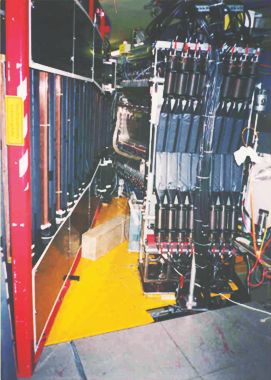 To describe strongly interacting compound particles (hadrons), representations in formalism of light front variables were developed by HEPI theoretical physicists. The method found a practical application to describe hadron processes at high energy. The researchers’ fundamental research on this subject was in advance by almost five years of similar research by foreign physicists noted in scientific literature. A cycle of their published works on this subject, with a summary overview of 60 pages was published in the very authoritative Physics Reports journal at the request of its editorial board. The team, V.Garsevanishvili, A.Khelashvili, Z.Menteshashvili and M.Nioradze was awarded the Georgian National Prize in 2010.
To describe strongly interacting compound particles (hadrons), representations in formalism of light front variables were developed by HEPI theoretical physicists. The method found a practical application to describe hadron processes at high energy. The researchers’ fundamental research on this subject was in advance by almost five years of similar research by foreign physicists noted in scientific literature. A cycle of their published works on this subject, with a summary overview of 60 pages was published in the very authoritative Physics Reports journal at the request of its editorial board. The team, V.Garsevanishvili, A.Khelashvili, Z.Menteshashvili and M.Nioradze was awarded the Georgian National Prize in 2010.
Experimental research on one of the current subjects of relativistic nuclear physics—the cumulative production of particles--is being carried out at HEPI. A main feature of this research maintains that the interaction of particles with nuclei secondary particles produced in the region of energies, forbidden for single nucleon interactions. It means that in the interacting process two or more nucleons of the target nucleus participate simultaneously. The description of qualitative and quantitative properties of the cumulative process is impossible in the framework of the traditional representations of nuclear physics on the internal movement of nucleons and the scattering of incident particle on nucleons. It requires a hypothesis for the existence of dense multi-quark states (6q, 9q, 12q etc.), the size of which is within the dimensions of nucleons. The nucleus should be considered as a mix of two phases of hadron matter: nucleon and quark-gluon plasma. Today it isn’t clear whether these are formed by an interaction of an incident hadron with the nucleus, or are created and decayed in the nucleus as a result of a fluctuation of nuclear matter density.
THEORETICAL INVESTIGATIONS
Theoretical research is being conducted in three directions: spin physics, three-quarks bound systems and physics beyond the Standard Model.
1. Spin (or intrinsic angular momentum) is an important characteristic of elementary particles and particles’ system. Two sorts of particles exist naturally where spin value is concerned: bosons with integer spin in certain units and fermions with half-integer spin. Boson and fermion systems have clearly distinct behavior. Any number of bosons can occupy the same quantum state simultaneously, whereas no more than one fermion can do so. This property is known as the Pauli principle, and defines the stability of the Universe.
Fundamental particles of matter, quarks and leptons (electron, muon, tauon and their neutrinos), are carriers of a half spin. Protons and neutrons are formed from quarks and create the atomic nucleus. Nuclei together with electrons create atoms and molecules, the compound bricks of matter. Fermions play a great role in nature. Half spin particles are described by the Dirac equation, which is characterized by various sorts of symmetry with respect to space-time transformation. HEPI scientists identified an extra symmetry for the Dirac particles and the related conserved magnitude. In the non-relativistic limit (small velocities) this quantity transfers into the Laplas-Runge-Lentz conserved vector, which is well-known in classical physics. Conservation of this vector keeps the movement of planets in closed periodical orbits, while in atoms it ensures the degeneracy of spectrums.
About 20 scientific studies have been published on this subject and two monographs have appeared-- one in New York by A. Khelashvili in 2009, which was also awarded the Academician Ilia Vekua Prize.
2. It is well-known that the nonrelativistic quark model successfully describes three-quark bound states. However, for the baryons made of light quarks with a relatively high bound energy it is necessary to consider relativistic effects. Most consistently a fully relativistic-covariant approach can be carried out within the framework of the generalized Bethe-Salpeter equation for three particles. The research objective is a solution for the Salpeter equation on the three quarks bound states and construction of the wave function describing this system. The knowledge of this wave function will allow the calculation of all other characteristics of the system.
3. The success of the Standard Model does not in the least weaken theoretical arguments in favor of the “new physics”, which can be expected to manifest itself through Tev energies. Its discovery and identification are the most important challenge in high energy physics today, especially after finding the Higgs boson. Despite the successes of the Standard Model of elementary particle physics and the Standard Model of cosmology (based on the gravitational theory of the general theory of relativity), many profound theoretical and experimental reasons still exist to consider that both models are incomplete. It is very important to identify the manifestation of “new physics” and what advantages have to be given to different expansions of the SM. At the HEPI, theoretical research in this direction is carried out on some alternative approaches beyond the SM (in models with large extra dimensions) to study the “rare processes” phenomenology. Rare processes in view of the Feynman diagrams imply weak processes going in one loop, which don’t have a place in the first order of the perturbation theory.
INFORMATION TECHNOLOGY
Theoretical research is being conducted in three directions: spin physics, three-quarks bound systems and physics beyond the Standard Model.
1. Spin (or intrinsic angular momentum) is an important characteristic of elementary particles and particles’ system. Two sorts of particles exist naturally where spin value is concerned: bosons with integer spin in certain units and fermions with half-integer spin. Boson and fermion systems have clearly distinct behavior. Any number of bosons can occupy the same quantum state simultaneously, whereas no more than one fermion can do so. This property is known as the Pauli principle, and defines the stability of the Universe.
Fundamental particles of matter, quarks and leptons (electron, muon, tauon and their neutrinos), are carriers of a half spin. Protons and neutrons are formed from quarks and create the atomic nucleus. Nuclei together with electrons create atoms and molecules, the compound bricks of matter. Fermions play a great role in nature. Half spin particles are described by the Dirac equation, which is characterized by various sorts of symmetry with respect to space-time transformation. HEPI scientists identified an extra symmetry for the Dirac particles and the related conserved magnitude. In the non-relativistic limit (small velocities) this quantity transfers into the Laplas-Runge-Lentz conserved vector, which is well-known in classical physics. Conservation of this vector keeps the movement of planets in closed periodical orbits, while in atoms it ensures the degeneracy of spectrums.
About 20 scientific studies have been published on this subject and two monographs have appeared-- one in New York by A. Khelashvili in 2009, which was also awarded the Academician Ilia Vekua Prize.
2. It is well-known that the nonrelativistic quark model successfully describes three-quark bound states. However, for the baryons made of light quarks with a relatively high bound energy it is necessary to consider relativistic effects. Most consistently a fully relativistic-covariant approach can be carried out within the framework of the generalized Bethe-Salpeter equation for three particles. The research objective is a solution for the Salpeter equation on the three quarks bound states and construction of the wave function describing this system. The knowledge of this wave function will allow the calculation of all other characteristics of the system.
3. The success of the Standard Model does not in the least weaken theoretical arguments in favor of the “new physics”, which can be expected to manifest itself through Tev energies. Its discovery and identification are the most important challenge in high energy physics today, especially after finding the Higgs boson. Despite the successes of the Standard Model of elementary particle physics and the Standard Model of cosmology (based on the gravitational theory of the general theory of relativity), many profound theoretical and experimental reasons still exist to consider that both models are incomplete. It is very important to identify the manifestation of “new physics” and what advantages have to be given to different expansions of the SM. At the HEPI, theoretical research in this direction is carried out on some alternative approaches beyond the SM (in models with large extra dimensions) to study the “rare processes” phenomenology. Rare processes in view of the Feynman diagrams imply weak processes going in one loop, which don’t have a place in the first order of the perturbation theory.
FUTURE PLANS
In the future we will take part in two international projects that concern fundamental problems of modern physics, in which German and Japanese colleagues have expressed the desire for our participation.
The first addresses the electric dipole moments of elementary particles, an experiment within the framework of international collaboration JEDI (Juelich Electric Dipole moment Investigations) in the Jülich Research Center. As it is well known in the case of time reversal (T) and parity invariance (P), the existence of permanent electric dipole moments for particles is forbidden. Therefore, its observation for proton, deuteron and other light nuclei will be a direct indication of the violation of these invariances, and consequently the CP invariance. It is essential to perform the EDM measurements on different targets with similar sensitivities in order to discover the underlying physics and to unveil the baryogenesis process. While neutron EDM experiments are pursued at many different locations worldwide, no such measurements have been conducted yet for protons and other light nuclei due to special difficulties in applying electric fields on charged particles. The finite lifetime of neutrons is an obvious restriction and, added to the practical limitations of obtaining a large number of ultracold neutrons, imposes a limit on the sensitivity of the neutron EDM experiments. Stable protons, coupled with readily available high intensity of polarized and cooled proton and deuteron beams would permit overcoming that limitation by at least an order of magnitude over the best projected neutron EDM sensitivities.
The EDM measuring method applies to charged particles, which constitutes a novelty in itself, and is based on the spin precession of a particle due to its magnetic and electric dipole moments in external electromagnetic fields, while circulating in a storage ring. Freezing the horizontal spin motion, i.e., forcing the particles’ spin to always point along the direction of motion, cancels the (g-2) precession caused by the anomalous magnetic moment. During a typical storage time of about 1000 seconds, the build-up of a vertical polarization component in the beam indicates the signal for a finite EDM of the orbiting particles. The principal observable of every EDM experiment is the angle of precession of the spin in an electric field, which boils down to the product of an electric field times the precession (observation) time. EDM research on charged fundamental particles has hitherto been impossible because of the absence of the necessary class of storage rings. The new EDM research method employs radial electric fields (for deuterons and 3He magnetic fields) to steer the particle beam in the machine. For this purpose a new special storage ring with radial electric field on the basis of the COSY accelerator of the Jülich Research Center will be built.
The second project will permit the study of the coherent transition of muon into electron in view of the lepton number (flavor) violation. Each lepton generation (e, υe; µ, υµ; τ, υτ) is characterized by a corresponding quantum number – flavor. Recently, the violation of conservation of the charged lepton flavor is the subject of theoretical and experimental research. The great interest in these investigations is linked to the expectation that they perhaps contain new physics effects, which will be observable in high precision experiments.
According to the Standard Model, in elementary particle reactions one has to incur the conservation of the lepton intrinsic quantum magnitudes – electron Le and muon Lμ flavors. An obvious process of a violation of this law is the mˉ – eˉ coherent conversion: mˉ + N(A,Z) → eˉ + N(A,Z), when the nucleus remains in the ground state. A captured muon starts to transfer to the low energy level of the muonic atom until it reaches the ground state. Thereafter according to the SM, the muon will have to decay in orbit mˉ → eˉ + υμ + antiie, or will be captured by nucleus mˉ + (A,Z) → υμ + (A,Z-1).
Looking beyond the Standard Model one may imagine an exotic process: the capture of a muon without neutrino radiation, i.e. mˉ – eˉ conversion. In this process conservation of lepton flavors Le and Lμ is violated but a total lepton flavor L=Le+Lμ is conserved. The implementation of this project is planned at the J-PARC (Japan Proton Accelerator Research Complex). Experimental investigations will be performed within the international framework of COMET (COherent Muon to Electron Transition) in which Georgia as well as scientific research institutions from the USA, Canada, China, Japan, England, Russia and Vietnam will participate. Creation of the high intensive muon source and the improved proton beam guarantee a higher level of quality and performance for this precision experiment than was heretofore possible.

